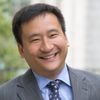The more I learn about Asian Americans, the less I know. What I mean, as with any subject of study, is that once you start reading you realize how much there is that you assumed and how much there is that nobody has yet investigated. But the more I teach about Asian Americans, the more I recognize how little anybody knows. Even Asian Americans themselves, immigrant and native-born, are, due to no fault of their own, ignorant of this history and the facts. Yet my story of discovery, of claiming rather than refusing Asian American identity for myself, is not unique. This year’s winner of a major award in social studies education, Noreen Naseem Rodriguez, has had the same experience. She will receive the Larry Metcalf Exemplary Dissertation Award prize from the National Council for Social Studies at their conference in San Francisco next month for her research on how Asian American teachers add curriculum about Asian Americans. She shared with me how she developed her interest.
Rodriguez is herself Asian American. She also knew nothing about what that name refers to until she was a graduate student. Rodriguez is “Pakipino,” a term she and others invented as a description: her father is an immigrant from Pakistan, Muslim; her mother an immigrant from the Philippines, Catholic. Their family was not alone. Her father’s best friend, who introduced her parents, was Pakistani as well, and he, too, married a Filipina. Thanks to there being two families who socialized, they felt normal in cultures and cuisines. Assessed by the metrics of the internet era, she informed me the hashtag “Pakipino” is, as kids say, “a thing.”
With her skin color and features, everyone in her home state of Texas mistook her for Latina. She ended up with a Chicano husband, making their two daughters “Mexi-Pakipino.”
Rodriguez, who was born and brought up in San Antonio, then found that the standard analysis of Asian Americans emphasized the populations on the East Coast or West Coast. Her parents had come together in Houston, which has become the most diverse city in the nation, statistically more so than New York City or Los Angeles. As a bilingual teacher, fluent in Spanish, she worked with the children in the classroom who were predominantly Latino/a. They regarded anything Asian as "chino," from karate to sushi to pandas. Other than her, they likely would not meet another Asian American teacher or any Asian American authority figure. She felt a responsibility to introduce Asian American content.
Determined to show that race is not simply a “black-white binary” and Asian Americans are not limited to the coasts, she was excited to teach a course at University of Texas Austin about Asian Americans just before she received her doctorate. Without exception, her students reported being like her. They had not been exposed to any background on Asian Americans. They were attracted to the opportunity to become familiar with themselves.
I identify. While I now am the age of my students’ parents, meaning a generation has passed since I, as a college sophomore, wrote a term paper about Asian Americans, we have not made much progress measured by the “core” and the canon for primary and secondary school. When as an undergraduate I went to the library to look in the card catalog, which dates me, I found there were exactly two books, volumes 1 and 2 in an edited series, about Asian Americans in the “stacks.” Now, there is much more that academics have documented about the Asian presence dating back much earlier than any would suppose, possibly to the earliest contact of outsiders with this continent. However, other than perhaps the building of the transcontinental railroad the Pacific half of which was the work of Chinese immigrants and maybe the internment of Japanese Americans during World War II (deemed by some too controversial to mention), the average youngster is not likely to hear about Asians in America at all. Part of the problem is that their teachers hadn’t been prepared either. Before Asian Americans can argue that they were integral to this democracy, they have to overcome being ignored in the first place.
“None of us had gotten this before,” she told me. Her project and her own example will change that. As she shows in her dissertation, it takes effort. Teachers have to be motivated, and in turn inspire their students. “Asian American” is dynamic, not static. “Mexi-Pakipinos,” like adoptees and new arrivals, are joining our experiment of self-governance.
“It’s powerful,” she said of Asian Americans encountering themselves on the syllabus. Their parents and grandparents may have landed long ago, but they do not belong until they are alongside the Pilgrims and Native Americans in the Thanksgiving lesson.
I thank Rodriguez for her contribution. It expresses the optimism of America.
